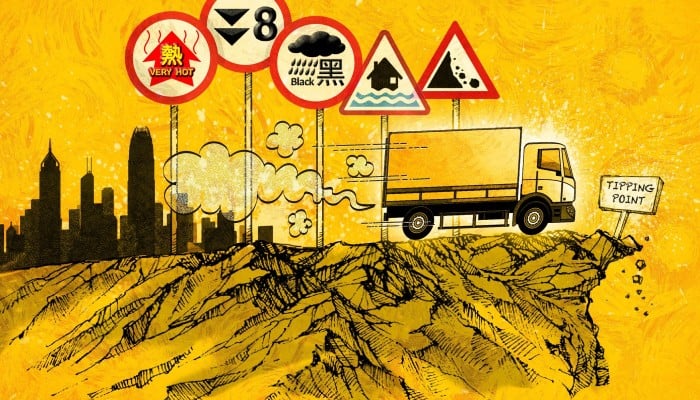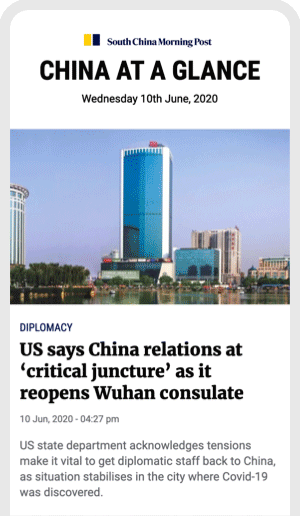Dear Global Impact readers,
Hot, isn’t it?
Across the northern hemisphere, temperatures are soaring and wreaking havoc on daily lives.
It’s summer, so it’s supposed to be warmer, but what’s really going on?
In this issue, Eugene Tang, the SCMP’s business editor, recaps the recent run of hot weather that offers more evidence of climate change and looks at what can be done.
Andrew Mullen
Deputy Editor, Political EconomyHow to keep cool and stay green
The hottest day for the northern hemisphere in 2022 occurs this weekend, when the scorching sun’s awesome power is at its maximum as it moves to the celestial longitude of 120 degrees.
This annual day, known in Chinese as Dashu – or Great Heat – on the lunar calendar, has been foretold for millenia, observed by farmers over thousands of years to plan their planting and harvests.
In Hong Kong, the maximum daily temperature has already risen past 35 degrees Celsius (95 degrees Fahrenheit). So far, the city has had more than 10 “very hot days” since July 8, when the mercury soared to 33 degrees Celsius, and it is one of the longest streaks of extreme heat since records began in 1884. Another run of such scorchers has been forecast for next week.
This summer’s extreme heat has already wreaked havoc on the northern hemisphere, killing hundreds of people in Spain and Portugal, triggering forest fires in southwestern Europe and disrupting dozens of flights after part of the tarmac at London Luton Airport melted during an unusually hot day.Half of China has been affected by the unusually hot spell over the past month. The Yangtze River basin – encompassing megacities from Shanghai on the coast to Chongqing in the interior – has been hit by a week-long heatwave. Chongqing, China’s biggest municipality, had four straight days of 40-plus degrees Celsius, and forecasters believe this trend will continue.
All of these episodes – combined with violent storms, super typhoons and tornadoes in unusual places – offer more evidence of climate change and serve as dire warnings to political leaders, businesses and individuals that they must act now to cut back on the emissions of carbon dioxide and other greenhouse gases.
Greenhouse gases blanket the planet, trapping heat close to the Earth’s surface and causing temperatures to rise. Emissions jumped by 6 per cent last year to a record 36.3 billion tonnes, as factories cranked up their post-coronavirus production after a lull in 2020. Particularly worrying was the heavy reliance on coal-fired power plants amid spiralling prices of natural gas.
Over the past three decades, Hong Kong has grown warmer at the rate of 0.24 degrees Celsius every 10 years – twice the pace of the previous decade. The city has become warmer at a rate of around 1.3 degrees Celsius every century, and the average temperature is projected to rise by 1.5 to 3 degrees Celsius by 2100.
Hong Kong and Macau are among the least-prepared cities within China’s Greater Bay Area for any storm surges during bouts of extreme weather. The risks to the region’s combined population of 86 million people will only increase, as typhoons become more intense, and sea levels rise with worsening climate change.
Four in every 10 of Macau’s population of 700,000 residents live less than five metres (16.4 feet) above sea level, as do around 10 per cent of Hong Kong’s 7.5 million people, according to the World Bank. That leaves a lot of people in harm’s way, as global sea levels may rise 10-25cm (3.9-9.8 inches) by 2050, according to the Intergovernmental Panel on Climate Change.
Still, humanity appears to be unprepared. The demand for air conditioning is such that China’s maximum power load hit an all-time high of 1.2 billion kilowatts one day last week.
Amid the scorching heat, it is admittedly hard to fight the urge to reach for the air conditioner. Still, keeping the thermostat just 1 degree warmer in summer, and leaving it 1 degree cooler in winter, translates to tremendous savings in the fight to avert climate change.
Every 1 degree Celsius difference in temperature for a space of 3,000 sq ft (279 square metres) in Hong Kong translates to 750 kilowatt hours (kWh) of electricity usage, or HK$1,100 (US$140) in annual power bills, according to CLP Power. In environmental terms, that translates to 292kg (644lbs) of carbon emissions, based on CLP’s 2021 greenhouse gas emission footprint of 0.39kg for every kWh of electricity produced.
But is it realistic to resist the air conditioners, at least for those who have them, when it’s a blistering 35 degrees Celsius outside? In Hong Kong, residents of the city’s notorious subdivided flats bear the brunt of the heat, forcing them to seek refuge at parks and in stairwells.
Japan has shown it can be done. Former environment minister Yuriko Koike introduced a campaign in 2005 for office workers to liberalise their dress codes – shed the suit and tie, and wear short-sleeved shirts – in summer so they can keep the thermostat at 28 degrees Celsius. The campaign, called CoolBiz, was embraced by the private sector, with a line of fashion to match. In winter, the campaign turned to WarmBiz, where offices and homes were encouraged to adjust the heater’s thermostat 1 degree Celsius lower to save electricity.
The upshot of the CoolBiz campaign was it helped Japan cut 460,000 tonnes of carbon emissions in 2005, the equivalent of emissions by 1 million households for a month. The campaign was even more successful in 2006, resulting in an estimated reduction of 1.14 million tonnes, or the emissions by 2.5 million households for a month.
The campaign, which has been promoted every year since 2005, has been adopted in South Korea. Hong Kong is following in kind, if not in name. Everbright Securities, Bank of China Hong Kong, the Hong Kong Monetary Authority, the Securities and Futures Commission, and developers including Hongkong Land, Sun Hung Kai Properties, Hang Lung Properties, Sino Land, Swire Properties and Link Reit are among the entities working to fight climate change.
Hong Kong's de facto central bank and the Securities and Futures Commission are among the entities relaxing dress codes to cut back on air conditioning, while the major property developers are deploying a variety of tactics, including digital technology, to slash office-energy use.
In all our different ways, we can act to keep cool and stay green to do our bit to avert climate change.
- South China Morning Post, SCMP -
Dear Global Impact readers,
Hot, isn’t it?
Across the northern hemisphere, temperatures are soaring and wreaking havoc on daily lives.
It’s summer, so it’s supposed to be warmer, but what’s really going on?
In this issue, Eugene Tang, the SCMP’s business editor, recaps the recent run of hot weather that offers more evidence of climate change and looks at what can be done.
Andrew Mullen
Deputy Editor, Political EconomyHow to keep cool and stay green
The hottest day for the northern hemisphere in 2022 occurs this weekend, when the scorching sun’s awesome power is at its maximum as it moves to the celestial longitude of 120 degrees.
This annual day, known in Chinese as Dashu – or Great Heat – on the lunar calendar, has been foretold for millenia, observed by farmers over thousands of years to plan their planting and harvests.
In Hong Kong, the maximum daily temperature has already risen past 35 degrees Celsius (95 degrees Fahrenheit). So far, the city has had more than 10 “very hot days” since July 8, when the mercury soared to 33 degrees Celsius, and it is one of the longest streaks of extreme heat since records began in 1884. Another run of such scorchers has been forecast for next week.
This summer’s extreme heat has already wreaked havoc on the northern hemisphere, killing hundreds of people in Spain and Portugal, triggering forest fires in southwestern Europe and disrupting dozens of flights after part of the tarmac at London Luton Airport melted during an unusually hot day.Half of China has been affected by the unusually hot spell over the past month. The Yangtze River basin – encompassing megacities from Shanghai on the coast to Chongqing in the interior – has been hit by a week-long heatwave. Chongqing, China’s biggest municipality, had four straight days of 40-plus degrees Celsius, and forecasters believe this trend will continue.
All of these episodes – combined with violent storms, super typhoons and tornadoes in unusual places – offer more evidence of climate change and serve as dire warnings to political leaders, businesses and individuals that they must act now to cut back on the emissions of carbon dioxide and other greenhouse gases.
Greenhouse gases blanket the planet, trapping heat close to the Earth’s surface and causing temperatures to rise. Emissions jumped by 6 per cent last year to a record 36.3 billion tonnes, as factories cranked up their post-coronavirus production after a lull in 2020. Particularly worrying was the heavy reliance on coal-fired power plants amid spiralling prices of natural gas.
Over the past three decades, Hong Kong has grown warmer at the rate of 0.24 degrees Celsius every 10 years – twice the pace of the previous decade. The city has become warmer at a rate of around 1.3 degrees Celsius every century, and the average temperature is projected to rise by 1.5 to 3 degrees Celsius by 2100.
Hong Kong and Macau are among the least-prepared cities within China’s Greater Bay Area for any storm surges during bouts of extreme weather. The risks to the region’s combined population of 86 million people will only increase, as typhoons become more intense, and sea levels rise with worsening climate change.
Four in every 10 of Macau’s population of 700,000 residents live less than five metres (16.4 feet) above sea level, as do around 10 per cent of Hong Kong’s 7.5 million people, according to the World Bank. That leaves a lot of people in harm’s way, as global sea levels may rise 10-25cm (3.9-9.8 inches) by 2050, according to the Intergovernmental Panel on Climate Change.
Still, humanity appears to be unprepared. The demand for air conditioning is such that China’s maximum power load hit an all-time high of 1.2 billion kilowatts one day last week.
Amid the scorching heat, it is admittedly hard to fight the urge to reach for the air conditioner. Still, keeping the thermostat just 1 degree warmer in summer, and leaving it 1 degree cooler in winter, translates to tremendous savings in the fight to avert climate change.
Every 1 degree Celsius difference in temperature for a space of 3,000 sq ft (279 square metres) in Hong Kong translates to 750 kilowatt hours (kWh) of electricity usage, or HK$1,100 (US$140) in annual power bills, according to CLP Power. In environmental terms, that translates to 292kg (644lbs) of carbon emissions, based on CLP’s 2021 greenhouse gas emission footprint of 0.39kg for every kWh of electricity produced.
But is it realistic to resist the air conditioners, at least for those who have them, when it’s a blistering 35 degrees Celsius outside? In Hong Kong, residents of the city’s notorious subdivided flats bear the brunt of the heat, forcing them to seek refuge at parks and in stairwells.
Japan has shown it can be done. Former environment minister Yuriko Koike introduced a campaign in 2005 for office workers to liberalise their dress codes – shed the suit and tie, and wear short-sleeved shirts – in summer so they can keep the thermostat at 28 degrees Celsius. The campaign, called CoolBiz, was embraced by the private sector, with a line of fashion to match. In winter, the campaign turned to WarmBiz, where offices and homes were encouraged to adjust the heater’s thermostat 1 degree Celsius lower to save electricity.
The upshot of the CoolBiz campaign was it helped Japan cut 460,000 tonnes of carbon emissions in 2005, the equivalent of emissions by 1 million households for a month. The campaign was even more successful in 2006, resulting in an estimated reduction of 1.14 million tonnes, or the emissions by 2.5 million households for a month.
The campaign, which has been promoted every year since 2005, has been adopted in South Korea. Hong Kong is following in kind, if not in name. Everbright Securities, Bank of China Hong Kong, the Hong Kong Monetary Authority, the Securities and Futures Commission, and developers including Hongkong Land, Sun Hung Kai Properties, Hang Lung Properties, Sino Land, Swire Properties and Link Reit are among the entities working to fight climate change.
Hong Kong's de facto central bank and the Securities and Futures Commission are among the entities relaxing dress codes to cut back on air conditioning, while the major property developers are deploying a variety of tactics, including digital technology, to slash office-energy use.
In all our different ways, we can act to keep cool and stay green to do our bit to avert climate change.
|
Was this newsletter forwarded to you? Subscribe here
|

|
|
|
|
|
23 July 2022 |
|
Welcome to our 1,511 newly joined SCMP Global Impact readers who signed up in the past week.
|
|
Dear Global Impact readers,
Hot, isn’t it?
Across the northern hemisphere, temperatures are soaring and wreaking havoc on daily lives.
It’s summer, so it’s supposed to be warmer, but what’s really going on?
In this issue, Eugene Tang, the SCMP’s business editor, recaps the recent run of hot weather that offers more evidence of climate change and looks at what can be done.
Andrew Mullen
Deputy Editor, Political Economy
How to keep cool and stay green
The hottest day for the northern hemisphere in 2022 occurs this weekend, when the scorching sun’s awesome power is at its maximum as it moves to the celestial longitude of 120 degrees.
This annual day, known in Chinese as Dashu – or Great Heat – on the lunar calendar, has been foretold for millenia, observed by farmers over thousands of years to plan their planting and harvests.
In Hong Kong, the maximum daily temperature has already risen past 35 degrees Celsius (95 degrees Fahrenheit). So far, the city has had more than 10 “very hot days” since July 8, when the mercury soared to 33 degrees Celsius, and it is one of the longest streaks of extreme heat since records began in 1884. Another run of such scorchers has been forecast for next week.
This summer’s extreme heat has already wreaked havoc on the northern hemisphere, killing hundreds of people in Spain and Portugal, triggering forest fires in southwestern Europe and disrupting dozens of flights after part of the tarmac at London Luton Airport melted during an unusually hot day.
Half of China has been affected by the unusually hot spell over the past month. The Yangtze River basin – encompassing megacities from Shanghai on the coast to Chongqing in the interior – has been hit by a week-long heatwave. Chongqing, China’s biggest municipality, had four straight days of 40-plus degrees Celsius, and forecasters believe this trend will continue.
All of these episodes – combined with violent storms, super typhoons and tornadoes in unusual places – offer more evidence of climate change and serve as dire warnings to political leaders, businesses and individuals that they must act now to cut back on the emissions of carbon dioxide and other greenhouse gases.
Greenhouse gases blanket the planet, trapping heat close to the Earth’s surface and causing temperatures to rise. Emissions jumped by 6 per cent last year to a record 36.3 billion tonnes, as factories cranked up their post-coronavirus production after a lull in 2020. Particularly worrying was the heavy reliance on coal-fired power plants amid spiralling prices of natural gas.
Over the past three decades, Hong Kong has grown warmer at the rate of 0.24 degrees Celsius every 10 years – twice the pace of the previous decade. The city has become warmer at a rate of around 1.3 degrees Celsius every century, and the average temperature is projected to rise by 1.5 to 3 degrees Celsius by 2100.
Hong Kong and Macau are among the least-prepared cities within China’s Greater Bay Area for any storm surges during bouts of extreme weather. The risks to the region’s combined population of 86 million people will only increase, as typhoons become more intense, and sea levels rise with worsening climate change.
Four in every 10 of Macau’s population of 700,000 residents live less than five metres (16.4 feet) above sea level, as do around 10 per cent of Hong Kong’s 7.5 million people, according to the World Bank. That leaves a lot of people in harm’s way, as global sea levels may rise 10-25cm (3.9-9.8 inches) by 2050, according to the Intergovernmental Panel on Climate Change.
Still, humanity appears to be unprepared. The demand for air conditioning is such that China’s maximum power load hit an all-time high of 1.2 billion kilowatts one day last week.
Amid the scorching heat, it is admittedly hard to fight the urge to reach for the air conditioner. Still, keeping the thermostat just 1 degree warmer in summer, and leaving it 1 degree cooler in winter, translates to tremendous savings in the fight to avert climate change.
Every 1 degree Celsius difference in temperature for a space of 3,000 sq ft (279 square metres) in Hong Kong translates to 750 kilowatt hours (kWh) of electricity usage, or HK$1,100 (US$140) in annual power bills, according to CLP Power. In environmental terms, that translates to 292kg (644lbs) of carbon emissions, based on CLP’s 2021 greenhouse gas emission footprint of 0.39kg for every kWh of electricity produced.
But is it realistic to resist the air conditioners, at least for those who have them, when it’s a blistering 35 degrees Celsius outside? In Hong Kong, residents of the city’s notorious subdivided flats bear the brunt of the heat, forcing them to seek refuge at parks and in stairwells.
Japan has shown it can be done. Former environment minister Yuriko Koike introduced a campaign in 2005 for office workers to liberalise their dress codes – shed the suit and tie, and wear short-sleeved shirts – in summer so they can keep the thermostat at 28 degrees Celsius. The campaign, called CoolBiz, was embraced by the private sector, with a line of fashion to match. In winter, the campaign turned to WarmBiz, where offices and homes were encouraged to adjust the heater’s thermostat 1 degree Celsius lower to save electricity.
The upshot of the CoolBiz campaign was it helped Japan cut 460,000 tonnes of carbon emissions in 2005, the equivalent of emissions by 1 million households for a month. The campaign was even more successful in 2006, resulting in an estimated reduction of 1.14 million tonnes, or the emissions by 2.5 million households for a month.
The campaign, which has been promoted every year since 2005, has been adopted in South Korea. Hong Kong is following in kind, if not in name. Everbright Securities, Bank of China Hong Kong, the Hong Kong Monetary Authority, the Securities and Futures Commission, and developers including Hongkong Land, Sun Hung Kai Properties, Hang Lung Properties, Sino Land, Swire Properties and Link Reit are among the entities working to fight climate change.
Hong Kong's de facto central bank and the Securities and Futures Commission are among the entities relaxing dress codes to cut back on air conditioning, while the major property developers are deploying a variety of tactics, including digital technology, to slash office-energy use.
In all our different ways, we can act to keep cool and stay green to do our bit to avert climate change.
|
|
|
|
|
|

|
|
Why China’s Gen Z see climate change as less important than their Western peers
|
| • |
Unlike their Western peers, protecting the environment is low on the list of public concerns for China’s Generation Z, surveys and interviews show | | | • | China’s green initiatives have been part of a top-down agenda and have had little to do with young people and the mass consumer market, expert says
|
|
|
Chinese university student Li Xiying would rather make the 10-minute walk from her dormitory to the campus cafeteria than accumulate a pile of takeaway containers, plastic utensils and bags. But she is often the only one among her friends. Her five roommates usually order food delivery – even from the university cafeteria – said the 22 year old, who is studying in Zhuhai city in Guangdong province. Read more
|
|

|
|
Can Hong Kong help cut through the alphabet soup of global ESG rules?
|
| • |
The world has at least 200 sets of standards for reporting and assessing climate and sustainability risks, mostly created without coordination among different jurisdictions | | | • | The International Sustainability Standards Board (ISSB) will set “baseline” sustainability reporting standards, starting with climate-related issues
|
|
|
As the world’s governments and corporations face up to sustainability risks amid extreme weather patterns under the Earth’s changing climate, regulators are inching towards creating a common standard out of an alphabet soup of regulations. The world has at least 200 sets of standards for reporting and assessing climate and sustainability risks, most of them created in recent years without coordination between regulators, industry guilds, companies or financial institutions across different jurisdictions. Read more
|
|

|
|
|

|
|
Can the Greater Bay Area withstand the high tide of climate change?
|
| • |
The coasts of Shenzhen and Guangzhou are protected by sea walls against storm surges with the force seen once in every 100 to 200 years | | | • | Hong Kong and Macau are less resilient against storm-surge threats from typhoons, coastal subsidence and government adaptation policies, climate advocates say
|
|
|
One afternoon last July, storm water crashed an underground retaining wall at Guangzhou Metro’s Shenzhou Road station, forcing the subway operator to shut Line 21 for seven hours, as a torrential downpour lashed southern China’s largest metropolis. Guangzhou received 74.4 millimetres (3 inches) of rain within an hour that day, an unseasonably violent storm in a city that typically gets three times that precipitation over an entire month. Read more
|
|

|
|
|

|

|
|
Sweltering heat in Hong Kong, extreme weather show need to act now, scientists say
|
| • |
Dramatic floods, heatwaves, wildfires tell world’s political leaders, businesses time for action is running out | | | • | Rising sea levels will increase frequency of flooding, with low-lying coastal areas and island nations most at risk
|
|
|
Humanity’s need to tackle climate change is more pressing than ever, with the United Nations warning last week that global warming would accelerate at a faster-than-expected pace over the next 20 years. In this four-part series, the Post examines its impact on the city, how the Hong Kong government can best play catch-up, and who is walking the talk in the private sector. Part one looks at how human activity is leading to extreme weather patterns, leaving the world vulnerable to floods, forest fires and typhoons. The Taklamakan Desert in China’s western Xinjiang province is one of the driest places in the country, where only 1cm (0.4 inches) of rain falls every year. Read more
|
|

|
|
Carbon neutrality: China sowing seeds of change to meet 2060 target
|
| • |
To meet the goal, China must cut its reliance on fossil fuel to 25 per cent by 2050 from the current 85 per cent, removing much of the rest with carbon capture and storage technology | | | • | The world will have to look to the Chinese government’s 14th Five-Year Plan from 2021 to 2025 for details of how every energy-intensive industrial segment should work toward the 2060 target
|
|
|
This third part of a series on China’s carbon neutrality goal looks at the social transformations and technological hurdles along the path to meet the government’s target in 2060. The rest of the series is here. . China’s renewable energy industry is poised to lead an unprecedented industrial transformation that would turn the world’s largest greenhouse gases emitter into a carbon neutral country in less than four decades, at an estimated cost of US$5 trillion. Read more
|
|
|
To keep track of the latest global news developments, follow daily coverage on our website or focus on stories about climate change.
In our next issue, Lunar – a Post initiative that highlights key issues related to women and gender equality in Asia – will look back at how the attack on four women in the coastal city of Tangshan has opened up the debate on gender–based violence in China.
We welcome your feedback. Email me at globalimpact@scmp.com or tweet me at @EugeneTang8. Plus, be sure to check out our Business feed for the latest news and analysis.
All the best,
|

|
|
Eugene Tang
Editor, Business
|
|
|
|
|
|
|
Hello, thank you for reading Global Impact.
Our mission is to lead the global conversation about China and this flagship newsletter is one way our Editorial team contributes toward this goal.
Serving readers and helping them get closer to stories that matter are paramount to us because keeping abreast of today’s news cycle has never been more important.
Understanding China means understanding the world. For more in-depth, expert coverage on how China and Asia impact the world, please consider a digital subscription to SCMP.
|
|
|
|
|
| SCMP NEWSLETTERS THAT MAY INTEREST YOU |

China at a Glance
A wealth of insights giving you the inside story on China every day.
China Economic Update
The latest developments from trade relations to growth rates and other key economic data.
Inside China Tech
Our weekend newsletter covering the biggest stories and updates from the tech centres of China.
VIEW AND SIGN UP
|

|
|

|
|
|
Hong Kong
China
Asia
World
Economy
Business
Tech
Comment
|
|
|
|
This email was sent to [email]
unsubscribe from this list
update subscription preferences
South China Morning Post Publishers Ltd · 19/F Tower 1 · 1 Matheson Street · Hong Kong · Hong Kong
Copyright © 2022 South China Morning Post Publishers Ltd. All rights reserved.
|















